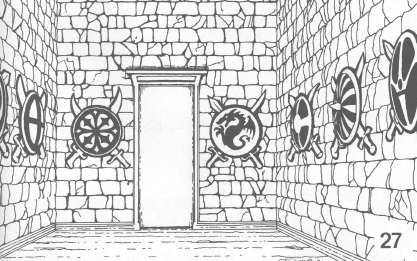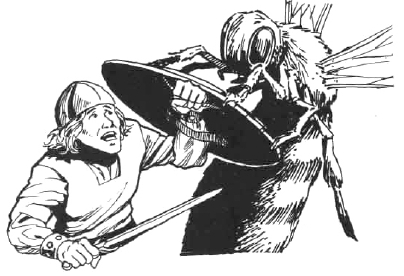Shield-using skills in the AD&D® game
In Defense of the Shield
by Tim Merret

-
A shield embodies protection, safety, and
succor in the heat of battle. Everybody
with 2 cents of AD&D® game knowledge
grabs a shield for all 1st-level characters
that can use one. "That's one more
point of armor class," they declare smugly.
But is it that easy? Does everyone have an
inborn talent for shield use, or is it that
characters don?t need to have any specific
knowledge to properly handle one? (?Here,
boy, take this. If somebody takes a swing
atcha?, throw it in front of ya. An? do some
cuttin? yerself.")
A shield is like many other pieces of
equipment in the AD&D game. The purchase
of a set of thieves? tools, for example,
does not grant the ability to use them.
The same is true of a weapon. Thus, we
have our present dilemma: Is it fair to
assume that a person could use a shield to
full advantage without prior training?
Probably not. For example, an inexperienced
PC might not be able use the shield
in a manner which would not interfere
with his swing. He may expose himself at a
bad time as a result, allowing the enemy
an easy strike. Furthermore, a shield the
size of a buckler presents its own problems:
It is so small that it would take a
good deal of practice to use it for defense.
Now assume that a PC has learned to use
all shields in general. Is it logical to say
that all shields provide the same amount
of protection? How can something the size
of a buckler cover a defender as well as a
large shield? Certainly, a buckler is more
mobile, but it is not necessarily as effective
as its larger counterparts. Follow this train
of thought a little further. In DRAGON® <LTH: Shield
& Weapon Skills>
issue #57, Len Lakofka tells us that nearly
two-thirds of all blows are caught by a
shield. This would seem to make the shield
far more effective as protection than the
single point of armor class it presently
provides.
A new shield system

To put this into game terms, characters
should be required to take a weapon proficiency
in shield use in order to use a
shield properly. In addition, characters
should be required to take further proficiencies
to gain full advantage of the various
shield types. Table 1 should be
consulted when considering shield use.
The armor-class column shows how
much protection each shield provides if
the user is sufficiently proficient. The to
hit column gives penalties to hit for all
attack rolls that are suffered by a nonproficient
user of a shield. Additionally, the
nonproficient user gains but one point of
armor class no matter what shield is used
(the exception to this being the buckler; <spiked
buckler>
such a shield would be useless for defense,
but could still be used for attacking, as
described on page 78 of Unearthed
Arcana).
Note the addition of a new shield, the
mantlet, which was mentioned in previous
issues of DRAGON Magazine. The mantlet
was actually employed in hand-to-hand
combat during the Middle Ages. Oval or
rectangular in shape, the mantlet covers a
6? creature from head to toe. Attached to
the bottom of the mantlet is a hinged spike
that can be swung out and driven into the
ground to provide a standing defense. This
shield weighs 15 pounds and is considered
very bulky. A mantlet should sell for 20 gp.
When a single shield proficiency is taken,
it is assumed that the character has
taken a basic course in the use of all
shields. This single proficiency allows the
shield-user to do the following: disregard
the ?to hit? penalties given in Table 1; use a
buckler properly (reducing armor class by
one point); and, use all other shield types
with enough ability to reduce armor class
by two points. Each additional proficiency
taken provides another place of armor
class for the pertinent shield used until the
maximum protection allowed for each is
reached as shown on Table 1. Thus, after
three proficiencies are taken, all shields
are usable to full advantage.
Table 1
Protection by Shield Type
| Shield type |
Max. AC bonus* |
"To hit" penalty |
| Buckler |
1 |
0 |
| Small |
2 |
-1 |
| Large |
3 |
-2 |
| Mantlet |
4 |
-3 |
In order to arrive at the armor classes
given for each shield, several factors have
to be decided ? the most important being
the sizes of the different shields. The
buckler is stated as being 1? in diameter.
By extrapolating from the encumbrance
charts, we assume that a small shield is 2?
long and that a large shield is 4? in length.
We can also deduce that the widths of the
four shields are from smallest to largest:
1', 1½', 2', and 3'.
Additionally, a table on page 64
of the
Dungeon Masters Guide states that a target
of missile weapons receives beneficial
modifiers to AC for any cover or
concealment it might have. This would
also hold true for melee combat; it's a lot
harder to hit someone hiding behind cover.
Because of its more mobile defense, a
shield qualifies more as concealment than
as cover against missile fire -- unless, as in
the case of the mantlet, a user decides to
hide behind it. Table 2 illustrates this use
of a shield. The initial concealment
figure
is from the DMG, page 64. The percentage
in parentheses is a conjectural figure of
the degree to which a 6'-tall creature can
be concealed by each shield. Although not
a perfect match with the DMG's figures
on
page 64, this does provide, a sound basis
for correlation to shield protection.
Table 2
Percentage of Target Concealed
| Shield type |
Concealment |
AC bonus |
| Buckler |
25% (12%) |
+1 |
| Small |
50% (33%) |
+2 |
| Large |
75% (88%) |
+3 |
| Mantlet |
90% (100%) |
+4 |
When figuring a shields protection, it is
important to base the percentage figure
for concealment on that provided for a 6'
creature. A large shield would thus act as
a mantlet to a creature only 4' tall, but
would be considered small to a creature
12' in height.
Magical shields provide a special case. If
a shield is enchanted, it acts as if the bearer
has at least one point of shield proficiency
(assuming the bearer can use
shields). The bearer, also receives the
magical bonus as usual. If the bearer
already has proficiencies, he receives
whatever bonus is applicable.
Because shields now provide a varying
amount of protection, a determination
must be made of shield type each time
that a shield is found. Of all such shields
found, 75% will be large (good for
humans). Small shields have a 15% chance
to be found, and bucklers and mantlets
each have a 5% chance for appearance. Of
course, the DM can always predetermine
what is found.
Shields as weapons
A shield can also be a very effective
offensive tool. Remember the movies
wherein the hero uses a shield to run over
or bash his enemies into submission? The
combat system in the AD&D game is
simple
enough that adding these tactics would
not clutter it. There are actually provisions
for it in the game now.
The buckler is the only shield that can
be used for attack and defense in the same
round. Characters need not be proficient
to attack with a shield. The player must
state that a PC is going to attack with his
shield before any rolls are made that
round. The three forms of shield attack
are pummeling, pinning, and shieldrushing.
If a player is using System I, the first
method of unarmed combat described in
Unearthed Arcana (page 106),
these
attacks are resolved in the same manner
as are pummeling, grappling (pinning), and
overbearing (shield-rush) attacks. Pinning
differs from grappling only in that there
must be a wall or some sturdy object or
force against which to pin the opponent.
Note that if a shield-rush is successful, an
effort to pin the opponent to the floor
might then be attempted.
The exceptions to these rules of attack
are the buckler and mantlet. The former
always attacks as described in Unearthed
Arcana. The latter, because of its size,
cannot be used to pummel an opponent.
System II, the second method of unarmed
attack described in Unearthed Arcana,
is a bit more complex and requires the
further definition of a shields usefulness.
In pummeling, all shields are considered
large, hard objects (the buckler and
mantlet excluded as before). If the
defender can still effectively employ his
shield, it is figured into his armor class.
Pinning an opponent with a shield works
in the same manner as does a grappling
attack, with a couple of modifications. The
defender of such an attack would be able
to use his shield for defensive armor class.
In addition to the five methods given to
break free of a grapple, a pin may be
automatically broken after one round if
the defender?s strength is no more than
four points lower than that of the attacker.
Conversely, if the attacker?s strength is five,
or more points less than the defender?s, he
cannot successfully pin the opponent.
Shield-rushing and overbearing attacks
would not differ in use.
Final thoughts
On the whole, this system does not
adversely affect game balance, but it
allows for a more realistic use of the
shield. At the same time, it gives characters
something to work for. One might ask:
"Why make characters use valuable weapon
proficiencies to learn shield use?" The
reason is that it is not desirable for everyone
to be completely proficient with
shields. The additional protection given
would make it far and away the best nonweapon
proficiency. Without this system,
most characters would choose shield use
to avoid suffering from attacks. But if
weapon proficiencies are required, these
characters are not likely to have many
slots to spare until weapons proficiencies
are gained. Remember: A character with
an 18 dexterity, complete proficiency with
a mantlet, and a suit of full plate armor
has a frontal armor class of, -7! That type
of protection must be earned.
This system can be altered to fit any
individual campaign. One might decide to
restrict this bonus to fighters and rangers,
in the same manner that weapon specialization
is treated. This may not be such a
bad idea. One might also rule that, after
becoming completely proficient with
shields, each additional proficiency taken
in shield use provides a +1 initiative
bonus in striking the first blow. Shields
should count for more, and these are just
a few suggestions to make them do so.